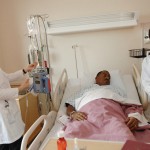PHARMACISTS SAY AUTOMATED DISPENSING CABINETS (ADCs) can bring efficiencies to the care of patients in the emergency department (ED), but it’s important to ensure that nurses aren’t worried about being administratively locked out of the devices during a crisis.
 Patricia C. Kienle, director of accreditation and medication safety for Cardinal Health Innovative Delivery Solutions, gave two examples of how such a crisis might come about: “A patient presents as a ‘John Doe,’ or it’s a trauma patient who you just have to take care of right away.”
Patricia C. Kienle, director of accreditation and medication safety for Cardinal Health Innovative Delivery Solutions, gave two examples of how such a crisis might come about: “A patient presents as a ‘John Doe,’ or it’s a trauma patient who you just have to take care of right away.”
At such times, she said, patient care trumps everything—including the usual procedures for logging the patient into the electronic medical record (EMR) system, routing medication orders to the pharmacy for verification, and releasing the drugs to nurses at the ADC.
“It happens in every hospital,” Kienle said. And, she said, hospitals devise different solutions to give ED nurses quick access to medications in such situations.
Michelle C. Corrado, system director of pharmacy services for Hallmark Health System Inc., of Medford, Massachusetts, said her organization’s ED nurses can use a “911 dummy” account in the Pyxis ADC when medications are needed for a patient whose information has not been entered into the EMR system.
“This was a way . . . for them to get access to the life-saving meds that they need without the patient’s name,” Corrado said. “It’s [for] somebody who’s unresponsive or unconscious or has no identification, and there’s no family there to help with the registration process, and they just need meds to get the patient out of the critical stage.”
William W. Churchill, chief of pharmacy services at Brigham and Women’s Hospital in Boston, said there’s no such dummy account to allow urgent access to the Omnicell ADCs in his institution’s ED. But nurses can manually create an entry in the devices for specific patients whose information isn’t available when a medication is urgently needed.
“They might type in ‘Smith, John, medical record number 123456789.’ And the Omnicell will accept that, and the nurse can get the drug,” Churchill said.
Corrado said any medication in the ADC can be removed by using the 911 dummy account. But she said the nursing staff is expected to use the patient’s correct account as soon as it’s available instead of continuing to remove medications using the 911 dummy code.
Both pharmacists said these solutions require pharmacy staff to be diligent about following up to make sure their dispensing records are accurate.
“Our informatics team gets a report of all the 911 entries that are made,” Corrado said. “So we can go back and get the information from the nurse in terms of who is ultimately attached to that so that we can get all the billing and everything correct.”
 Corrado said the reconciliation process isn’t difficult, but it does involve manual data entry to correct the patients’ accounts.
Corrado said the reconciliation process isn’t difficult, but it does involve manual data entry to correct the patients’ accounts.
A critical component of ADC use at Brigham and Women’s was the development of a list of medications subject to automatic pharmacy verification through the EMR system. Nurses can pull those medications from the ADCs, effectively overriding the pharmacy review.
“We have a defined list, which was done collaboratively between the ED, medical, nursing, and pharmacy. And we also collaborated and agreed upon which orders would be ‘autoverify’ and which would require a pharmacist’s review,” Churchill said.
He said an ADC in a trauma room will contain more autoverify medications than a dispensing device located elsewhere in of the ED.
“When a patient is in need, we need to be able to provide that drug,” Churchill said.
Overrides, like dummy accounts, must be reconciled, he said.
“We get a report that’s generated the next day. Then we ask the pharmacists that are staffing in the area to take a look at the overrides and make sure that they’re appropriate,” Churchill said.
Andrew Kaplan, pharmacy supervisor at St. Catherine of Siena Medical Center in Smithtown, New York, said his hospital installed ADCs in the ED nearly a decade ago after consulting with the ED staff about which medications to stock in the cabinets.
For situations when seconds count, as during “an absolute emergency,” Kaplan said, “we’ve created a dummy patient account called ’emergency patient’ to allow them to pull something out that’s urgently needed.”
We’re trying to leverage our electronic medical record and our automated dispensing cabinets to improve patient care.
In somewhat less urgent situations (e.g., a patient is not yet registered), nurses can type whatever information they have about the patient directly into the Pyxis unit and then obtain the medications, he explained.
“We encourage them to put in as much information as possible, so at least it gets entered as a temporary patient,” Kaplan said.
He said the hospital’s Epic EMR system is the brains behind the successful deployment of the Pyxis unit in the ED and the ability to reconcile dispensing records.
“Our Epic EMR knows everything that happens in Pyxis. So there’s a linkage between the two,” Kaplan said.
Kaplan said ADCs allow the pharmacy to store and manage “hundreds of units of medicines” in the ED and improve the drug delivery process in various ways.
“We’re trying to leverage our electronic medical record and our automated dispensing cabinets to improve patient care,” Kaplan said.
For example, he said, the Pyxis unit in the ED has “auxiliary towers” for the storage of i.v. antimicrobials and large-volume medication preparations. With this feature and changes to the EMR system, he said, nurses no longer “run back and forth from the emergency department to the pharmacy” to obtain i.v. aztreonam for patients with penicillin allergy. Now, he said, the drug is administered within an hour of ordering 64% of the time, compared with 16% of the time before the changes were made.
Linda Lipsky, director of pharmaceutical services at Methodist North Hospital in Memphis, Tennessee, since 1992, recalled that drug dispensing in the ED used to be “kind of a free-for-all,” with nurses essentially taking whatever they needed for their patients from medication carts.
When ADCs were first introduced, they didn’t really fix that problem, she said.
“There was no control over it at that point, because we didn’t have profiles,” Lipsky said, referring to the system through which the pharmacy views information in the EMR and reviews and verifies drug orders, allowing the release of medications from the ADCs. Without the profile process, she said, every medication in the ADC was essentially on override status.
Now, she said, her community hospital uses Omnicell ADCs with profiling enabled to ensure that a pharmacist reviews the orders before administration, with overrides allowed for emergencies.
Lipsky said pharmacy, nursing, and medical staff worked together to create the override list. Once the nurses became familiar with the profiling capabilities and the override drugs, the ADCs were better accepted, Lipsky said.
“Like any change that you make, it’s slow when you start because you’re not real familiar. But then once you get into it, it’s no big deal,” she said.
–By Kate Traynor, reprinted with permission from AJHP
(November 15, 2015; volume 72, pages 1921-1922)








 If you want to contribute tutorials, news or other stuff please contact us. We pay 150 for each approved article.
If you want to contribute tutorials, news or other stuff please contact us. We pay 150 for each approved article. Consectetur adipisicing elit. Sed do eiusmod tempor incididunt ut labore.
Consectetur adipisicing elit. Sed do eiusmod tempor incididunt ut labore. This site uses valid HTML and CSS. All content Copyright © 2010 Newscast, Inc
This site uses valid HTML and CSS. All content Copyright © 2010 Newscast, Inc If you like what we do, please don't hestitate and subscribe to our
If you like what we do, please don't hestitate and subscribe to our